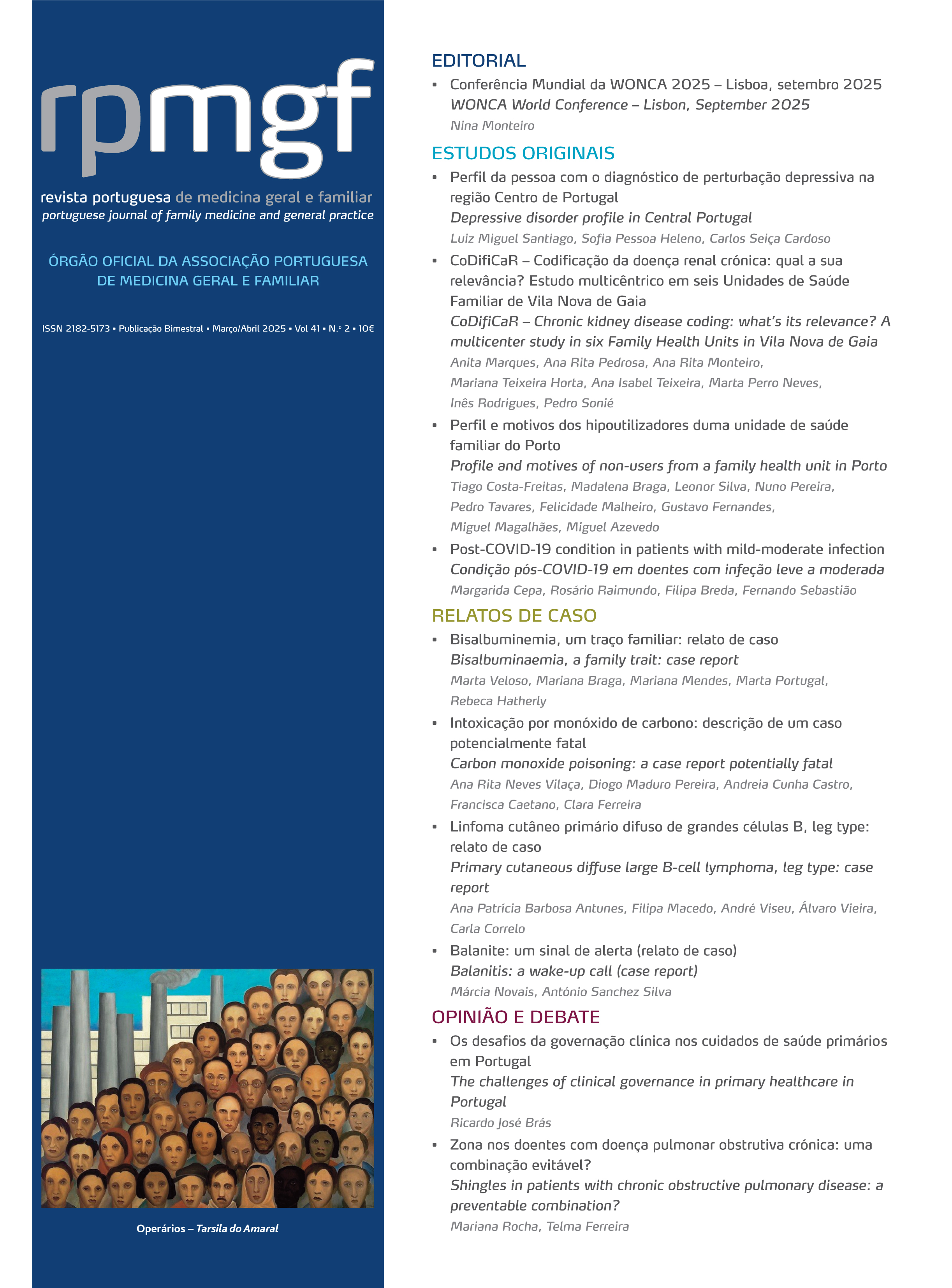Balanitis: a wake-up call (case report)
DOI:
https://doi.org/10.32385/rpmgf.v41i2.13998Keywords:
Balanitis, Candida albicans, Diabetes mellitus type 2, Case reportAbstract
Introduction: Balanitis is an inflammation of the glans penis often caused by C. albicans. Its diagnosis is clinical and it can be recurrent or resistant to pharmacological therapy, which should lead us to suspect occult diabetes mellitus. This case poses a diagnostic challenge, as it is now possible to diagnose diabetes long before these skin changes occur.
Description: The case report is about a 59-year-old male patient who reported penile irritation, increased sensitivity, phimosis of the foreskin, erectile dysfunction with intense pain, and penile erythema when having sex. Once the diagnosis of balanitis had been made, the patient began multiple antifungal/antimicrobial treatments (fluconazole, dexamethasone, and clotrimazole combination cream) to which resistance was observed. Because of this, about three months after the onset of symptoms, the diagnostic hypothesis of occult diabetes was raised, and the diagnosis was confirmed by fasting blood glucose. He was started on insulin and terbinafine, with symptomatic improvement and a reduction in glycemic values.
Comment: When faced with a case of balanitis that is resistant to pharmacological treatment, it is essential to be highly suspicious of a possible diagnosis of occult diabetes, and to include it as a differential diagnosis, regardless of any screening previously carried out. Family doctors are in a privileged position to recognize balanitis as a cutaneous manifestation of diabetes to make a timely diagnosis and prevent possible complications.
Downloads
References
1. Wray AA, Velasquez J, Leslie SW, Khetarpal S. Balanitis [Internet]. Treasure Island: StatPearls Publishing; 2020 [updated 2024 Aug 31]. Available from: https://www.ncbi.nlm.nih.gov/books/NBK537143/
2. Morris BJ, Krieger JN. Penile inflammatory skin disorders and the preventive role of circumcision. Int J Prev Med. 2017;8:32.
3. Jegadish N, Fernandes SD, Narasimhan M, Ramachandran R. A descriptive study of the clinical and etiological profile of balanoposthitis. J Family Med Prim Care. 2021;10(6):2265-71.
4. Saoji V, Achliya A. Balanoposthitis as a cutaneous marker of diabetes mellitus in an apparently healthy male. Our Dermatol Online. 2015;6(2):289-91.
5. Talapko J, Meštrović T, Škrlec I. Growing importance of urogenital candidiasis in individuals with diabetes: a narrative review. World J Diabetes. 2022;13(10):809-21.
6. Unnikrishnan AG, Kalra S, Purandare V, Vasnawala H. Genital infections with sodium glucose cotransporter-2 inhibitors: occurrence and management in patients with type 2 diabetes mellitus. Indian J Endocrinol Metab. 2018;22(6):837-42.
7. Huang YC, Huang YK, Chen CS, Shindel AW, Wu CF, Lin JH, et al. Phimosis with preputial fissures as a predictor of undiagnosed type 2 diabetes in adults. Acta Derm Venereol. 2016;96(3):377-80.
8. Nyirjesy P, Sobel JD. Genital mycotic infections in patients with diabetes. Postgrad Med. 2013;125(3):33-46.
9. Pandya I, Shinojia M, Vadukul D, Marfatia YS. Approach to balanitis/balanoposthitis: current guidelines. Indian J Sex Transm Dis AIDS. 2014;35(2):155-7.
10. Hedayati MT, Tavakoli M, Zakavi F, Shokohi T, Mofarrah R, Ansari S, et al. In vitro antifungal susceptibility of Candida species isolated from diabetic patients. Rev Soc Bras Med Trop. 2018;51(4):542-5.
11. Edwards SK, Bunker CB, van der Snoek EM, van der Meijden WI. 2022 European guideline for the management of balanoposthitis. J Eur Acad Dermatol Venereol. 2023;37(6):1104-17.
12. Engelhardt K, Ferguson M, Rosselli JL. Prevention and management of genital mycotic infections in the setting of sodium-glucose cotransporter 2 inhibitors. Ann Pharmacother. 2021;55(4):543-8.
13. Barrisford GW. Balanitis in adults. In: UpToDate [Internet]; 2024 [updated 2024 Apr 12; cited 2024 Aug 13]. Available from: https://www.uptodate.com/contents/balanitis-in-adults
Downloads
Published
Issue
Section
License
Copyright (c) 2025 Portuguese Journal of Family Medicine and General Practice

This work is licensed under a Creative Commons Attribution-NonCommercial-NoDerivatives 4.0 International License.
The authors will assign to the RPMGF the sole right to publish and distribute the content of the manuscript specified in this declaration via physical, electronic, broadcasting or any other medium that may come into existence. They also grant the RPMGF the right to use and exploit this manuscript, in particular by assigning, selling or licensing its content. This permission is permanent and takes effect from the moment the manuscript is submitted, has the maximum duration allowed by applicable Portuguese or international law and is of worldwide scope. The authors further declare that this assignment is made free of charge. If the RPMGF informs the authors that it is not going to publish their manuscript, the exclusive assignment of rights ceases forthwith.
The authors authorise the RPMGF (or any entity it may appoint) to act on their behalf when it believes that copyright may have been infringed.





